Artificial foundation was developed shortly after the invention of the removable frames. The first foundation frame was invented by Johannes Mehring in Germany (Graham, 1992). But as more people began producing artificial foundation for Langstroth hives, beekeepers began experimenting with different sized cells. Fast forward to today; we see both small cell and standard comb, but why is that? Well, that is the topic of part 2 of this 4-part blog series.
- History of comb management- https://beeinformed.org/2017/09/14/comb-management-part-1/
- Cell size: why so much variation between producers?
- Management strategies of foundation
- Benefits of replacing old comb
In part 1, I wrote about the history of comb management. In part 2, I decided to write about cell size. Cell size is a highly heated and debated topic that I, as a former commercial beekeeper, did not know of until recently. As a commercial beekeeper, we would buy foundation in bulk, which had a “standard” cell size (5.2mm to 5.4mm). I had zero concept of small versus standard cell size, and I became curious about why beekeepers would use small cell instead of standard cell. So I did what any eager millennial would do- I googled it. I found Michael Bush’s (http://www.bushfarms.com/beesnaturalcell.htm) and Randy Oliver’s post (http://scientificbeekeeping.com/trial-of-honeysupercell-small-cell-combs/) about small cell size (and I went down a few other rabbit holes), and I instantly became fascinated about small cell size. I hope you enjoy reading this blog as much as I enjoyed writing it.
In 1857, Johannes Mehring produced the first comb foundation (Graham, 1992). His goal was to provide bees with a template, which would encourage bees to build worker comb in the frames. From that day forward, artificial foundation became a part of beekeeping. However, beekeepers began to experiment with different cell sizes. In 1927, Baudoux hypothesized that larger cell sizes would produce larger bees, and based upon anecdotal evidence from his own colonies, he claimed larger bees produced higher yields of honey. Without scientific evidence, manufacturers in Belgium and France began to produce foundation with larger cells. These manufacturers asserted that bees raised in larger cells produced more honey and this concept took off (Grout, 1935). Those fallacies faded into history as cell size become standardized at 5.2mm-5.4mm.
| Natural Worker Comb | 4.6 mm to 5.1 mm |
| Dadant 4.9mm Small Cell | 4.9 mm |
| Honey Super Cell | 4.9 mm |
| Wax dipped PermaComb | 4.9 mm |
| Mann Lake PF100 & PF120 | 4.94 mm |
| 5.05 mm | |
| Dadant 5.1mm Small Cell | 5.1 mm |
| Pierco foundation | 5.2 mm |
| Pierco deep frames | 5.25 mm |
| Pierco medium frames | 5.35 mm |
| RiteCell | 5.4 mm |
| Standard Worker Foundation | 5.4 to 5.5mm |
| 7/11 | 5.6 mm |
| HoneySuperCell Medium Frames | 6.0 mm |
| Drone | 6.4 to 6.6 mm |
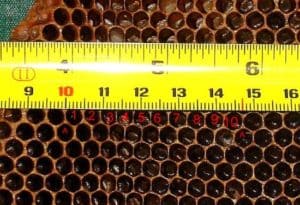
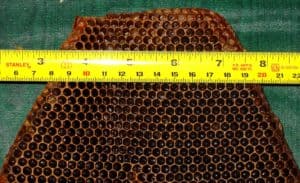
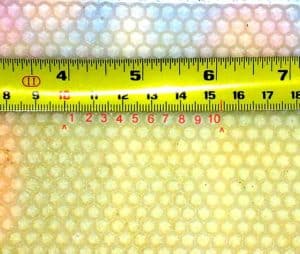
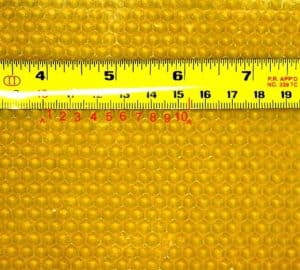
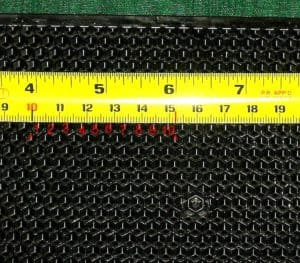
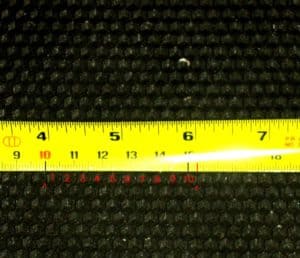
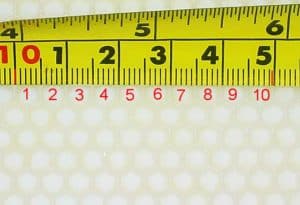
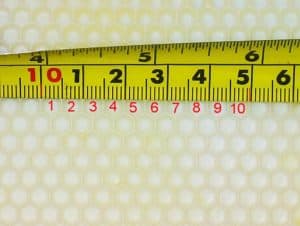

I decided to see if scientific studies supported Baudoux’s 2 major claims: 1) larger cells=larger bees and 2) larger bees=higher honey yield.
Claim #1-Smaller cells= smaller bees
Honey bees raised in smaller cells did, in fact, become smaller. Apis mellifera mellifera raised in small-cell (5.08mm) comb versus standard-cell (5.48mm) comb became 1% smaller (McMullan & Brown, 2006). Moreover, bees raised in small-cells did have smaller thorax width and head width, morphometrics determined during development (Grout, 1935; Seeley, Griffin, Seeley, & Griffin, 2011). Yes, an 8% reduction in cell size only equated to a 1% reduction in size, and we do not know what these reductions mean on a colony level. However, these experiments show how the rearing environment impacts the individual, and not how it may have colony level impacts. I should note that body size is likely not only impacted by cell size, but also other environmental factors such temperature, nutrition, etc.
My Verdict: Yes, but only to a point
Claim #2-Larger bees=higher honey yield
Let us think about this: larger bees have bigger thoraxes, which possibly means a more profound locomotor function (simply, flight) ( Seeley, & Griffin, 2011). So, do larger bees produce more honey? Well we know that, of 62 bee species analyzed, body size was correlated with how far an insect forages (Greenleaf et al., 2007). For honey bees, worker weight does vary during the season (Levin & Haydak., 1951) so it is possible that larger workers can forage longer distance. But do larger bees produce more honey? The answer seems to be no. Obviously, more studies are needed to support this idea because honey production is dependent upon both genetic and environmental factors. Moreover, these studies did not scientifically compare honey production for colonies raised with small-cell comb (5.08mm) versus standard-comb (5.48mm). However, from what we know in the scientific literature, body size does not impact honey production.
Let us jump from the brood nest to the honey super: can bees store more honey in standard-cell comb versus small-cell comb? From a pure speculative opinion, I would suspect bees would possibly store less (but probably not much less) honey in small-cell comb for 2 reasons: 1) frames would have more cells, but less honey storage/cell and 2) my guess is that colonies can draw out standard cells further than small-cell sized comb. Because of this, bees can store more honey per cell. Like I said, this is pure speculation, so if you have thoughts/experience, please comment below
My Verdict: No
Beekeepers began to implement small cell comb into their colonies as a possible non-chemical varroa mite control in the 1990’s. This hypotheses stemmed from observations of Africanized honey bees (bees that produce smaller cells sizes than European species) whom seemed less prone to becoming harmed from varroa; however, we also know that much of that reduced harm was from swarming when varroa mite levels became too high. While hygienic behavior was also known to explain low mite levels in Africanized honey bees, there was an idea that the smaller cell sizes could control varroa. I decided to see if studies have shown the efficacy of small cell size on varroa management
Claim #3-Can small cells actively control varroa
Medina & Martin (1999) hypothesized the use of smaller cell size as a varroa control because they believed smaller cell size inhibited movement of immature varroa, thus reducing the mites’ ability to feed. This idea was tested by Martin & Kryger (2002) whom found evidence for this hypothesis. These researchers reared a subspecies of European honey bees that are similar in size in small celled comb (4.6mm), and they found higher mother mite and male offspring mortality. They also observed the mother mites and male protonymphs appeared to get trapped in in the upper part of the cell, which inhibited their ability to reach feeding site on the developing bee. This evidence was exciting; an easily implement management strategy that could be used to control mites!! But good science required initial claims to be repeated and verified. So five separate studies conducted experiments to test whether small-cells can actively control mites (Berry, Owens, & Delaplane, 2010; Coffey, Breen, Brown, & McMullan, 2010; Ellis, Hayes, & Ellis, 2009; Seeley, & Griffin, 2011; Taylor, Goodwin, McBrydie, & Cox, 2008). These studies have not found evidence to support this point. In one of the studies, Dr. Tom Seeley compared mite loads and mite drops of bees reared in standard comb size (5.4mm) versus small cell size (4.8mm) and found no difference between groups (Seeley, & Griffin, 2011). Moreover, he noticed the volume of the cell filled by a larvae was only slightly larger for a small cell versus large cell. He suggested that Martin & Kryger (2002) possibly found significant differences between bees reared in different cell sizes because the largest subspecies (a non-European race), Apis mellifera capensis, was reared in the smallest possible cell size (4.6mm). Using European races, small cell size did not have a huge impact on colony mite levels.
Small cell size, I found from online forums and posts, is widely believed to actively control varroa. but based upon the literature, it seems small cell size comb cannot actively control for varroa.
Verdict: No
Until next time…..
Foundation is equipment that all beekeepers deal with, but what are the best methods and strategies for introducing foundation? Also, I discuss the differences between waxed and unwaxed foundation. I will discuss this and more about introducing foundation, which is truly the “foundation” of any colony.
Until next time…Cheers!
If you have thoughts/experience, please comment below! I attached links to Randy Oliver’s post about the topic:
http://scientificbeekeeping.com/trial-of-honeysupercell-small-cell-combs/
And like I linked before, Michael Bush has information in his post:
http://www.bushfarms.com/beesnaturalcell.htm
References
Berry, J. A., Owens, W. B., & Delaplane, K. S. (2010). Small-cell comb foundation does not impede Varroa mite population growth in honey bee colonies *. Apidologie, 41(1), 40–44.
Coffey, M. F., Breen, J., Brown, M. J. F., & McMullan, J. B. (2010). Brood-cell size has no influence on the population dynamics of Varroa destructor mites in the native western honey bee , Apis mellifera mellifera *. Apidologie, 41(5), 522–530.
Ellis, A. M., Hayes, G. W., & Ellis, J. D. (2009). The efficacy of small cell foundation as a varroa mite (Varroa destructor) control. Experimental and Applied Acarology, (47), 311–316. https://doi.org/10.1007/s10493-008-9221-3
Graham, J. M. (Ed.). (1992). The hive and the honey bee. Hamilton, IL: Dadant & Sons.
Greenleaf, S. S., Williams, N. M., Winfree, R., Kremen, C., Greenleaf, S. S., & Williams, N. M. (2007). Bee Foraging Ranges and Their Relationship to Body Size. International Association for Ecology, 153(3), 589–596. https://doi.org/10.1007/s00442-007
Grout, R. A. (1935). Influence of Size of Brood Cell upon Size and Variability of the Honeybee. American Association of Economic Entomologists, 345–354.
Levin, M. D., & Haydak., M. H. (1951). Seasonal Variation in Weight and Ovarian Development. Journal of Economic Entomology, 44(1), 54–57.
Martin, S. J., & Kryger, P. (2002). Reproduction of Varroa destructor in South African honey bees : does cell space influence Varroa male survivorship ? Apidologie, 33, 51–61. https://doi.org/10.1051/apido
McMullan, J. B., & Brown, M. J. F. (2006). The influence of small-cell brood combs on the morphometry of honeybees ( Apis mellifera )*. Apidologie, 37, 665–672.
Medina, L. M., & Martin, S. J. (1999). A comparative study of Varroa jacobsoni reproduction in worker cells of honey bees ( Apis mellifera ) in England and Africanized bees in Yucatan , Mexico, (September 1994), 659–667.
Seeley, T., Griffin, S., Seeley, T., & Griffin, S. (2011). Small-cell comb does not control Varroa mites in colonies of honeybees of European origin Small-cell comb does not control V arroa mites in colonies of honeybees of European origin. Apidologie, (42), 526–532. https://doi.org/10.1007/s13592-011-0054-4
Taylor, M. A., Goodwin, R. M., McBrydie, H. M., & Cox, H. M. (2008). The effect of honey bee worker brood cell size on Varroa destructor infestation and reproduction. Journal of Apicultural Research.